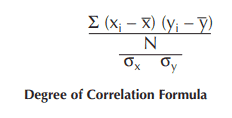Glossary “D” Definition of Terms in DataMyte
Defect
Departure of a quality characteristic from its acceptable level or state. The defects may also be classified by degree of seriousness. See also Nonconformity.
Defective Unit
A sample (part) that contains one or more defects, making the sample unacceptable for its intended, normal usage. See also Nonconforming Unit.
Deformation
The bending or distorting of an object due to forces applied to it. Deformation can contribute to errors in measurement if the measuring instrument applies enough force.
Degree of Correlation
The degree of correlation is defined by the formula below.
Degrees of Freedom (DF)
The number of unconstrained parameters in a statistical determination. For example, in determining x (the mean value of a sample of n measurements), the number of degrees of freedom, DF, is n. In determining the standard deviation (STD) of the same population, DF = n – 1 because one parameter entering the determination is eliminated. The STD is obtained from a sum of terms based on the individual measurements — which are unconstrained — but the nth measurement must now be considered constrained by the requirement that the values add up to make x. An equivalent statement is that one degree of freedom is factored out because the STD is mathematically indifferent to the value of x.
Discrete Variable
A variable that assumes only integer values; for example, the number of people in a room is a discrete variable.
Dispersion (of a statistical sample)
The tendency of the values of the elements in a sample to differ from each other. Dispersion is commonly expressed in terms of the range of the sample (difference between the lowest and highest values) or by the standard deviation. See also Standard Deviation.
Dispersion Analysis Diagram
A cause-and-effect diagram for analysis of the various contributions to variability of a process or product. The main factors contributing to the process are first listed, then the specific causes of variability from each factor are enumerated. A systematic study of each cause can then be performed.




